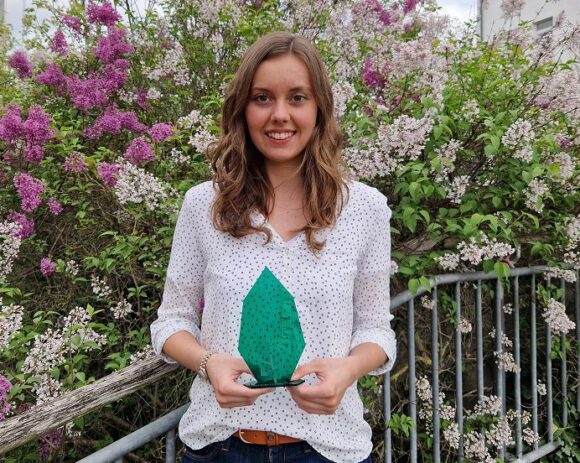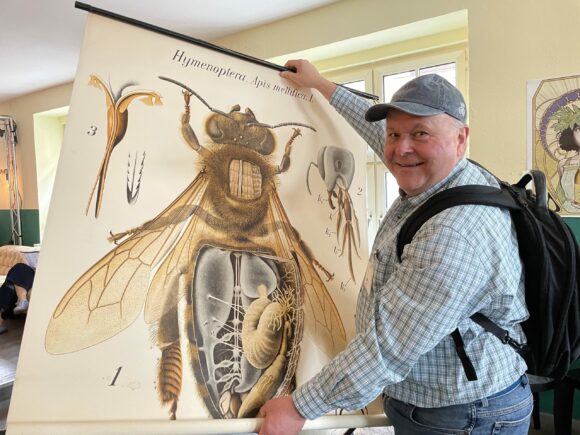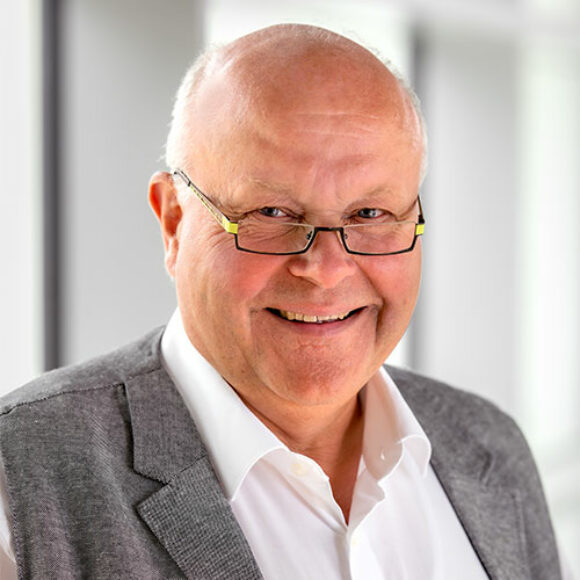The trade fair autumn of our research institutes continues: For three years it did not take place due to corona, but now the Institute for Applied Biopolymer Research of the Hof University of Applied Sciences (ibp) could finally participate as an exhibitor at the K trade fair in Düsseldorf. With more than 3000 exhibitors it is one of the leading fairs in the field of plastics and rubber industry. The institute presented its project EISBiR, which deals with the use of biogenic by-products as additives for bioplastics and the effects of ionizing radiation on bioplastics. We talked to Dr.-Ing. Mirko Rennert, the research group leader of EISBiR.

Mr. Rennert, did you have any experience with the trade fair beforehand?
Mirko Rennert: “As a junior research group EISBiR, we were at the K for the first time. In this respect, it was exciting from the exhibitor’s point of view to see: “How is our topic or our product received? When do I address interested parties, etc.”. As a visitor, I was at the K for the fourth time, and the others had already been there. From there, you know the visitor side, when sometimes you just want to take a quick look at what there is to see at the booth, without always being pulled directly into a conversation.”
How has the trade show changed after Corona?
“If you travel by public transport, you stand in a throng of people on the platform early on and virtually no one wears a mask. Then on the train almost everyone puts on the mask, so that then at the fair itself again almost no one wears mask. Basically, the fair was like before the pandemic. Many people from all over the world, close together in the exhibition rooms. The parking lots were also always packed. Even if some think that it was emptier than the years before, we did not have this feeling. It was noticeable that there were fewer really big players, but more joint stands with many innovative small companies and start-ups. You sometimes had to look for these specifically, but some of them had nice ideas and products waiting here that can be used to shape the way to a material change with more reuse – refurbishment and sharing tools instead of building new ones, more and cleaner recycling, energy-saving processes and, of course, the use of more local biomass sources for bioplastics and their additives as in our junior research group EISBiR.”
What was your goal there, why did you participate?
“We were explicitly invited by the project sponsor, the Agency for Renewable Resources FNR e.V., to present the research project EISBiR and progress on the topic of “renewable raw materials for bioplastics applications”. With us, a total of four projects were represented at the joint stand of the FNR. For us, therefore, a small honor and appreciation, since the FNR carries very many projects nationwide. We wanted to present our two main research areas – firstly, the use of biogenic by-products – for example coffee and wine by-products – as functional additives for bioplastics, and secondly, the use of ionizing radiation to improve the properties of bioplastics.

We had a lot there: in addition to exhibits such as films made from wine pomace and coffee parchment, filaments for 3D printing made from red wine pomace and barks, melt spun fibers and injection molded parts made from these to demonstrate an intrinsic reinforcement effect, there was also a showcase with biogenic powders and compounds made from them, a 3D printed vase and a red wine glass made from red wine pomace. Then we had summarized our most important research results and ran them on a tablet in a continuous loop
The goal was to point out the possibilities that biogenic by-products, which are unfortunately still considered “bio-waste,” give us. They can replace expensive and sometimes critical chemicals as natural additives.”
Dr.-Ing. Mirko Rennert
Radiation can be used to eliminate the need for additional additives, which reduces complexity and increases the range of properties of bioplastics. Many visitors were not even aware of such approaches, so we hope to be able to provide some inspiration in addition to numerous contacts and follow-ups.”
Did the trade show go as you had planned?
“We underestimated the daily arrival and departure. At least two hours every morning and evening, whether by public transport or by car. Without the trade show, it would have been only 45 minutes.
At the trade fair itself, things went well. We made a lot of contacts, the visitors were very interested and now we are already in further talks with the first ones. In addition, we networked with other exhibitors. Overall, I would have wished for more attention for the whole topic of “bioplastics”. Although almost every booth had something about “Future starts here”, “Green Innovation” or “Transparency” and “Circular Economy”, etc., on closer inspection it was often the same conventional products as in previous trade fair years.”
What happened in particular at the fair?
“What was exciting was that many large and well-known companies came to our booth, as well as a family man with his two sons. The two boys were still studying or just starting. With them, you immediately felt the desire that something has to change fundamentally in the plastics business. Both had a 3D printer at home and were thrilled when we showed them our filaments for the 3D printer made from purely natural ingredients. It was also nice that each of us was visited by acquaintances from previous jobs, training, studies, by friends, etc. So it was a good mix of familiar faces and new contacts.”

How did the junior group fare in everyday life at the trade fair?
“After all, we weren’t always there at full strength. We divided ourselves in such a way that there were always one or two at the stand. The rest were able to go about their daily work or take the opportunity to look for the latest innovations at the K themselves or even visit familiar contacts.
At the FNR booth there was also an Arburg injection molding machine for which we felt “responsible” among other things. Beverage lids were produced for the summer, so that wasps & Co. do not fly into the beloved beer or other drinks. These were all made from renewable raw materials and were given to the visitors as give-aways. So we always provided material supplies in the machine and distributed them diligently. The individual projects at the FNR booth also supported each other by sending interested people to the respective other booths.
The fair lasted eight days and afterwards everyone was well exhausted. In the evening, there was usually enough energy for a meal in Düsseldorf’s old town, but everyone needed the rest after the fair.”
What exactly did the cooperation with FNR consist of?
“The FNR manages the financial resources of the Federal Ministry of Food and Agriculture and helps decide which project applications are funded. Only project applications on the topic of “renewable raw materials” end up at the FNR. Thus, the FNR, which was represented primarily by Dr. Gabriele Peterek, responsible for PR at the FNR, was able to directly get an up-to-date picture of the progress of our junior research group.”







